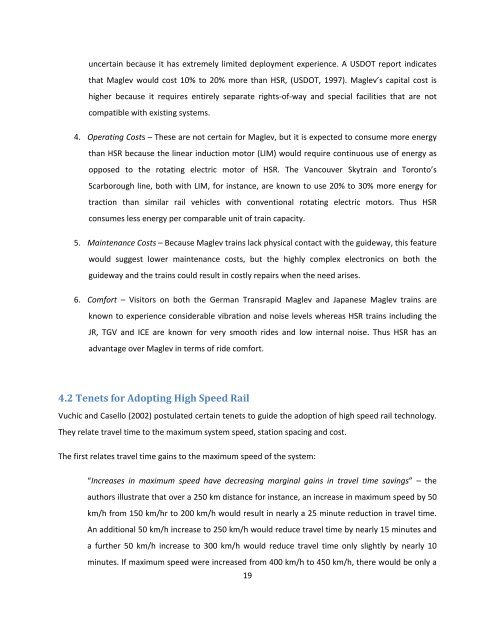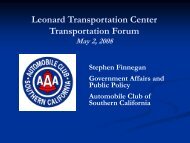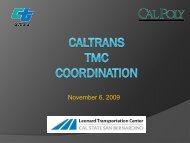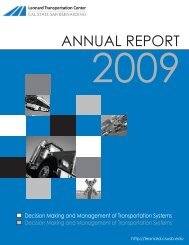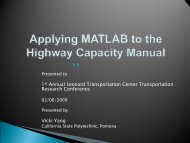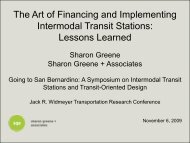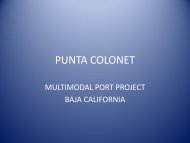Preliminaries to a Feasibility Analysis of the Maglev Proposal of The ...
Preliminaries to a Feasibility Analysis of the Maglev Proposal of The ...
Preliminaries to a Feasibility Analysis of the Maglev Proposal of The ...
Create successful ePaper yourself
Turn your PDF publications into a flip-book with our unique Google optimized e-Paper software.
uncertain because it has extremely limited deployment experience. A USDOT report indicates<br />
that <strong>Maglev</strong> would cost 10% <strong>to</strong> 20% more than HSR, (USDOT, 1997). <strong>Maglev</strong>’s capital cost is<br />
higher because it requires entirely separate rights‐<strong>of</strong>‐way and special facilities that are not<br />
compatible with existing systems.<br />
4. Operating Costs – <strong>The</strong>se are not certain for <strong>Maglev</strong>, but it is expected <strong>to</strong> consume more energy<br />
than HSR because <strong>the</strong> linear induction mo<strong>to</strong>r (LIM) would require continuous use <strong>of</strong> energy as<br />
opposed <strong>to</strong> <strong>the</strong> rotating electric mo<strong>to</strong>r <strong>of</strong> HSR. <strong>The</strong> Vancouver Skytrain and Toron<strong>to</strong>’s<br />
Scarborough line, both with LIM, for instance, are known <strong>to</strong> use 20% <strong>to</strong> 30% more energy for<br />
traction than similar rail vehicles with conventional rotating electric mo<strong>to</strong>rs. Thus HSR<br />
consumes less energy per comparable unit <strong>of</strong> train capacity.<br />
5. Maintenance Costs – Because <strong>Maglev</strong> trains lack physical contact with <strong>the</strong> guideway, this feature<br />
would suggest lower maintenance costs, but <strong>the</strong> highly complex electronics on both <strong>the</strong><br />
guideway and <strong>the</strong> trains could result in costly repairs when <strong>the</strong> need arises.<br />
6. Comfort – Visi<strong>to</strong>rs on both <strong>the</strong> German Transrapid <strong>Maglev</strong> and Japanese <strong>Maglev</strong> trains are<br />
known <strong>to</strong> experience considerable vibration and noise levels whereas HSR trains including <strong>the</strong><br />
JR, TGV and ICE are known for very smooth rides and low internal noise. Thus HSR has an<br />
advantage over <strong>Maglev</strong> in terms <strong>of</strong> ride comfort.<br />
4.2 Tenets for Adopting High Speed Rail<br />
Vuchic and Casello (2002) postulated certain tenets <strong>to</strong> guide <strong>the</strong> adoption <strong>of</strong> high speed rail technology.<br />
<strong>The</strong>y relate travel time <strong>to</strong> <strong>the</strong> maximum system speed, station spacing and cost.<br />
<strong>The</strong> first relates travel time gains <strong>to</strong> <strong>the</strong> maximum speed <strong>of</strong> <strong>the</strong> system:<br />
“Increases in maximum speed have decreasing marginal gains in travel time savings” – <strong>the</strong><br />
authors illustrate that over a 250 km distance for instance, an increase in maximum speed by 50<br />
km/h from 150 km/hr <strong>to</strong> 200 km/h would result in nearly a 25 minute reduction in travel time.<br />
An additional 50 km/h increase <strong>to</strong> 250 km/h would reduce travel time by nearly 15 minutes and<br />
a fur<strong>the</strong>r 50 km/h increase <strong>to</strong> 300 km/h would reduce travel time only slightly by nearly 10<br />
minutes. If maximum speed were increased from 400 km/h <strong>to</strong> 450 km/h, <strong>the</strong>re would be only a<br />
19


